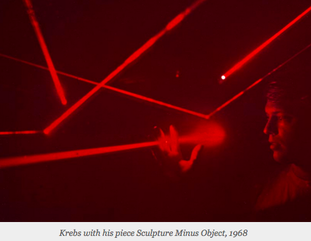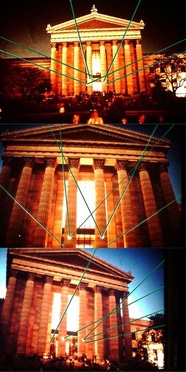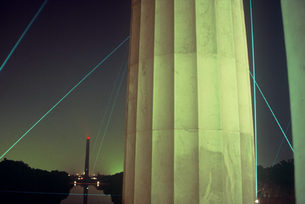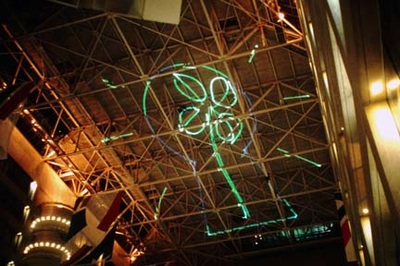Heather Krebs is faced with the task of archiving all of Rockne Krebs work @RockneKrebsArt #resculpt #sculpture https://t.co/ZEiejkGVs9 pic.twitter.com/JHb3dhUIRR
— Int Sculpture Center (@IntSculptureCtr) December 3, 2016
Re: Sculpt | International Sculpture Center, Nov. 30, 2016. Reestablishing Rockne by John Anderson12/24/2016
0 Comments
"When the Los Angeles County Museum of Art launched its first Art & Technology program back in 1967, the idea of artists and technologists collaborating was radical—and the art world wasn’t quite ready."GUESTS
|
|
“I think of these as pieces which you experience in total but see only in sequence or passages. The experience is a remembered experience, almost as a piece of music of which you hear the progression. In this case you see the progression of the piece and your final total experience is one of memory.”
Rockne Krebs, 1970 *2
“’Crazy, man!’ is the way young people describe it as the beam dances merrily as it bounces off trees, the waters of the lagoon…” *3
|
“I was disheartened to read Rockne’s 1977 statement, that of the thirty-eight major pieces he had made, only four were still extant.
Rockne’s sobering quote speaks volumes about the temporal nature of all art. However, there is one piece that certainly exists and has become a touchstone for me. Miami Line is a signature Krebs light sculpture that stretches for a third of a mile along the under edge of a Metrorail overpass in downtown Miami ….” *4
William Dunlap, Dec. 2, 2011
“...Krebs’s made one feel extremely happy and proud to be alive at a particular time and place…” *5
- HK
*1. Richard, Paul. Making It as An Artist, The Washington Post, 1977.
*2. The Sixth National Sculpture Conference, 1970, National Sculpture Center, the University of Kansas, Lawrence, KS. Edited by Elden C. Tefft, published 1971. Published transcript of Krebs’ lecture.
*3. Griffin, Thomas. One-the Beam Museum Draws ‘Em Like Moths, The States-Item New Orleans, 1971.
*4. Harrison, Carol. Rockne Krebs Photographs + Interpretations, 2013.
*5. Forgey, Benjamin. Art Life on the Edges, essay, Washington Art Matters: Art Life in the Capital 1940-1990, 2013.
*2. The Sixth National Sculpture Conference, 1970, National Sculpture Center, the University of Kansas, Lawrence, KS. Edited by Elden C. Tefft, published 1971. Published transcript of Krebs’ lecture.
*3. Griffin, Thomas. One-the Beam Museum Draws ‘Em Like Moths, The States-Item New Orleans, 1971.
*4. Harrison, Carol. Rockne Krebs Photographs + Interpretations, 2013.
*5. Forgey, Benjamin. Art Life on the Edges, essay, Washington Art Matters: Art Life in the Capital 1940-1990, 2013.
On this day in 1976, the Rockne Krebs Laser Sculpture installation at the St. Petersburg Municipal Pier was unveiled.
It consisted to two pieces. The laser beam configuration itself was titled, "Starboard" while the equipment installation inside the Pier was called, "Home on the Range, Part VI."
I was the Executive Director of the St. Petersburg Arts Commission and the Project Director for Rockne's work here. It was a really incredible and wondrous work of art so far ahead of its time that technology was not able to keep up with it.
Like laser light itself, it had a short but brilliant life.
- Glenn Anderson
St. Petersburg, FL. laser sculpture back in the news.
The Tampa Tribune, November 6, 2013,
1977 artist’s work debunks rumor of UFO in St. Pete, by Paul Guzzo
Documentation of a 1977 installation by laser artist Rockne Krebs was recently mistaken for documentation of a UFO landing.
A Florida newspaper debunks the myth.
Excerpt from Glenn Anderson’s remembrance in Rockne Krebs Photographs + Interpretations by Carol Harrison
A brief anecdote on my friendship with Rockne Krebs
“….I won’t go into details on the wonder of that artwork. When it was working, it was “other worldly” and the 8th wonder of the world. But
when it was broken down, it was a curse…The failure was not Rockne’s fault. He had done the best he could, and brilliantly, but he was always so far ahead of the curve as an artist, science had not kept up with reliable technology. In that day, large lasers were very temperamental and unreliable but if that was the medium an artist wanted to explore, he had few options.
….I was daily working with him in some way and we were connected at the hip in so far as our futures in St. Petersburg were concerned…. My close daily contact with Rockne gave me insight into both him as a human being and as an artist. As a functioning human being I experienced his incredible drive and work ethic. He was driven to see that next thing that “had never been seen before”…the ultimate goal of a highly functioning artist. As an artist, he was dedicated to the truth and purity of both concept as well as visual experience. The artist Rockne had to share the scientist Rockne….” 1*
- Glenn Anderson

1* Harrison, Carol. Rockne Krebs Photographs + Interpretations. 2013.
From the Archive: “The city at night is light” Krebs says, 1973.
“Sky Bridge Green is not the first enormous outdoor work of art that has been installed in Philadelphia by a Washington artist. As they leave the Philadelphia Museum, those laser beams pass over Franklin’s Footpath, a painting of multi-colored stripes by Washington’s Gene Davis that is 414 feet long and eight lanes of traffic wide. Franklin’s Footpath, which has been painted on the street at the foot of the museum’s hill was also commissioned by David Katzive.” Richard, Paul. The Washington Post, 1973, The City at Night Is Light.
Visiting Gene Davis' Franklin's Footpath, 1972.
It was the world's largest artwork at the time.
"Davis (1920-1985) opens pulsing color spaces that are entirely his own. I can't say how he does it. He couldn't explain it either. It has something to do with peripheral perception. At the edges of your vision even brilliant colors dim. Each time you choose to focus on a single stripe of color, the hues to either side of it inevitably change. Davis was able to arrange the unexpected dance of unexpected colors. "
Richard, Paul. The Washington Post, April 2007.
Richard, Paul. The Washington Post, April 2007.
Sky Bridge Green
The beams of light crisscrossed in the courtyard, bounced off angled mirrors on two flagpoles, crossed again as they returned to mirrors mounted on two of the columns, and then sailed overhead to City Hall, in the center of downtown Philadelphia, a mile and a half away. (In 1969 Krebs was granted a patent for his laser beam reflective system. Granted patent in six countries for the first 3-D laser piece, first in the field.)
“I was working at the Philadelphia Museum of Art back in 1973, when David Katzive, the head of the Museum's Division of Education and the Urban Outreach Program, commissioned Sky Bridge Green, which was one of the most extraordinary, beautiful artworks I have ever experienced. I watched Rockne tinker with the impressively huge laser that he had set up on the east portico of the Museum to shoot a beam of light straight down the Benjamin Franklin Parkway to a mirror on Billy Penn's hat on the top of City Hall.” William F. Stapp, December 2, 2012
“I was working at the Philadelphia Museum of Art back in 1973, when David Katzive, the head of the Museum's Division of Education and the Urban Outreach Program, commissioned Sky Bridge Green, which was one of the most extraordinary, beautiful artworks I have ever experienced. I watched Rockne tinker with the impressively huge laser that he had set up on the east portico of the Museum to shoot a beam of light straight down the Benjamin Franklin Parkway to a mirror on Billy Penn's hat on the top of City Hall.” William F. Stapp, December 2, 2012
| Krebs originally called the piece Sky Pi, he re-titled it Sky Bridge Green, perhaps after he and David Katzive met this man admiring the laser sculpture. “An elderly man, a stranger, was standing there at City Hall gazing in astonishment at the lights that came from the museum. When Krebs and Katzive then returned to the museum, they met the man again, staring at the light above him, climbing the museum steps. 'It’s like walking into heaven,' said the stranger.” Richard, Paul. The Washington Post, 1973, The City at Night Is Light. Sky Bridge Green was a bridge to the sky hovering above Davis' Franklin’s Footpath. |
Rockne Krebs’ lasers pierce the Philadelphia air
“Important among the sources of Rockne Krebs’s art are acknowledged early debts to Caro (openness and concern with actual space) and Noland (rigorous intellectual control of formal elements)….but just how far and how independently he has pushed them can be seen in the outdoor laser piece commissioned last spring by the Philadelphia Museum of Art.
When read from below strictly from the point of view of style, the piece was like an excessively simple sculpture somehow suspended in the sky.
Yet it was impossible to read the piece merely as a formalist tour de
force. The piece emphasized with great tact and intelligence the street pattern of the city, in this case the broad, arrow-straight line of Franklin Boulevard that leads directly from City Hall to the knoll on top of which sits the museum temple. It interacted strikingly with other man-made aspects of its environment: fountains, equestrian statues, office buildings, street lights…These relationships changed radically as one changed one’s vantage point, and in view of the enormous territory covered by the piece, these possibilities were immense…” Forgey, Benjamin. Art in America, September-October 1973, Rockne Krebs at the Philadelphia Museum of Art.
When read from below strictly from the point of view of style, the piece was like an excessively simple sculpture somehow suspended in the sky.
Yet it was impossible to read the piece merely as a formalist tour de
force. The piece emphasized with great tact and intelligence the street pattern of the city, in this case the broad, arrow-straight line of Franklin Boulevard that leads directly from City Hall to the knoll on top of which sits the museum temple. It interacted strikingly with other man-made aspects of its environment: fountains, equestrian statues, office buildings, street lights…These relationships changed radically as one changed one’s vantage point, and in view of the enormous territory covered by the piece, these possibilities were immense…” Forgey, Benjamin. Art in America, September-October 1973, Rockne Krebs at the Philadelphia Museum of Art.
"Krebs, for all his precision, thinks about light like a mystic…"
“He is not the first Washington artist to work the same terrain. On their way from the museum hill to city hall those two brilliant laser beams zing high above the enormous, multi-colored section of Franklin Boulevard that Gene Davis covered with long stripes last summer…
How is it beautiful? How is it art? What is it, in fact, that Krebs has done? In the first place, unlike many of the unhappy couplings of art and technology… in the heady days of the mid-‘60s, Krebs’s laser environments represent a triumph of vision of over technique.
After all, the idea of making “sculpture” out of a non-material “substance” such as light is in itself an incisive bit of poetry, and when you get down to it, Krebs, for all his precision, thinks about light like a mystic…
On Franklin’s Footpath, Davis’ street painting, the trees enveloped me in almost total darkness. The laser beams seemed like everlasting comet trails – pure, inexplicable, beautiful.” Forgey, Benjamin. The Evening Star and The Washington Daily News, May 1973, A Spectacle of Light.
How is it beautiful? How is it art? What is it, in fact, that Krebs has done? In the first place, unlike many of the unhappy couplings of art and technology… in the heady days of the mid-‘60s, Krebs’s laser environments represent a triumph of vision of over technique.
After all, the idea of making “sculpture” out of a non-material “substance” such as light is in itself an incisive bit of poetry, and when you get down to it, Krebs, for all his precision, thinks about light like a mystic…
On Franklin’s Footpath, Davis’ street painting, the trees enveloped me in almost total darkness. The laser beams seemed like everlasting comet trails – pure, inexplicable, beautiful.” Forgey, Benjamin. The Evening Star and The Washington Daily News, May 1973, A Spectacle of Light.
”It is not just beautiful, it is important. For Krebs… has found a way of making monumental urban sculptures viable again. How sad it is to see the
aging statues sprinkled through cities. They once seemed large as life, or larger, but they seem so no longer…It is the city that has killed them…where the city pushes in the monuments seem lost. Our cities are too big, too busy, all sculpture seems too small. Krebs’ work, as you might guess, is huge...It succeeds because it is not made of steel, or of bronze or plastic. It is made of light….Though weightless and insubstantial, they manage to wholly dominate their visual competition." Richard, Paul. The Washington Post, 1973, The City at Night Is Light. *This article appeared in several other newspapers around the country and abroad.
aging statues sprinkled through cities. They once seemed large as life, or larger, but they seem so no longer…It is the city that has killed them…where the city pushes in the monuments seem lost. Our cities are too big, too busy, all sculpture seems too small. Krebs’ work, as you might guess, is huge...It succeeds because it is not made of steel, or of bronze or plastic. It is made of light….Though weightless and insubstantial, they manage to wholly dominate their visual competition." Richard, Paul. The Washington Post, 1973, The City at Night Is Light. *This article appeared in several other newspapers around the country and abroad.
"His experience with outdoor pieces is already extensive…I think by now he can claim to be the master of an exhilarating, unprecedented type of “city sculpture.” Forgey, Benjamin. Art in America, September-October 1973, Rockne Krebs at the Philadelphia Museum of Art
“I found myself thinking of an evening in 1973, in balmier weather, when I walked from my apartment a few blocks from the Art Museum to see another temporary installation there, Sky Bridge Green by Rockne Krebs.
It consisted of a green laser beam shot from the Art Museum to a mirror atop City Hall and bounced several times across the Parkway. The atmosphere was like a party. People kept throwing objects to see if they could make this monumental beam of light disappear for a split second.
It was so much fun seeing the amazing light and the community it created,
I went back for several more evenings to see it again and again.
The Krebs piece dramatized the polarities of the Parkway — with one end in the heart of the city with its commerce and politics, the other at the Art Museum, representing aesthetic contemplation and the gateway to a natural world beyond. On the ground, the Parkway often falls short, but Krebs’ work shined a new kind of light on the ideals that brought it into being.”
- Hine, Thomas. The Philadelphia Inquirer, January 24, 2019.
- HK
RockneKrebsArt is now on Twitter. Please follow @RockneKrebsArt
The latest from RockneKrebsArt (@RockneKrebsArt).
Rockne Krebs b:1938 - d: 2011 was a contemporary American artist. A pioneering artist, Krebs was recognized for his monumental sculptural work with laser light · RockneKrebsArt.com
The latest from RockneKrebsArt (@RockneKrebsArt).
Rockne Krebs b:1938 - d: 2011 was a contemporary American artist. A pioneering artist, Krebs was recognized for his monumental sculptural work with laser light · RockneKrebsArt.com
Commentary on the Art of Rockne Krebs
Please share your thoughts.
x.com/RockneKrebsArt
Click to see @RockneKrebsArt's
tweets since 2012.
via Instagram
Categories
All
Art And Technology
Comments & Thoughts The Art Of Rockne Krebs
Drawings
From The Rockne Krebs Archives
Gene Davis
Philadelphia Museum Of Art
Plexiglas Sculptures
Public Art
Solar Art
Strathmore Fine Art
Studies & Prints
Urban Scale Laser Sculpture
Urban-Scale Laser Sculpture
What’s Up: New Technologies In Art


















 RSS Feed
RSS Feed
